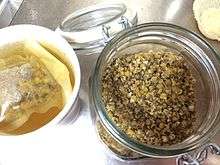Chamomile
Chamomile (American English) or camomile (British English; see spelling differences) (/ˈkæməˌmaɪl,
Etymology
The word "chamomile" derives, via French and Latin, from Greek χαμαίμηλον (khamaimēlon), i.e. "earth apple", from χαμαί (khamai) "on the ground" and μῆλον (mēlon) "apple".[3][4] The spelling "chamomile" corresponds to the Latin and Greek source.[5] The spelling "camomile" is a British derivation from the French.[6]
Species
Some commonly used species include:
- Matricaria chamomilla (also known as Water of Youth'),[7] German chamomile[8] or wild chamomile, the most commonly used species
- Chamaemelum nobile, Roman, English or garden chamomile, also frequently used,[8] (C. nobile ‘Treneague’ is normally used to create a chamomile lawn).[9]

A number of other species' common names include the word "chamomile". This does not mean they are used in the same manner as the species used in the herbal tea known as "chamomile." Plants including the common name "chamomile," of the family Asteraceae, are:
- Anthemis arvensis, corn, scentless or field chamomile
- Anthemis cotula, stinking chamomile
- Cladanthus mixtus, Moroccan chamomile
- Cota tinctoria, dyer's, golden, oxeye, or yellow chamomile
- Eriocephalus punctulatus, Cape chamomile
- Matricaria discoidea, wild chamomile or pineapple weed
- Tripleurospermum inodorum, wild, scentless or false chamomile
Infusion
Chamomile tea is an herbal infusion made from dried chamomile flowers and hot water. Two types of chamomile used are German chamomile (Matricaria recutita) and Roman chamomile (Chamaemelum nobile).
Research
Chamomile is under preliminary research for its potential anti-anxiety properties.[7] Chemical compounds present within chamomile include numerous polyphenols which have unknown effects in humans.[7]
Drug interactions
Apigenin and other compounds may interact with medications causing drug-drug interactions, some of the possible interactions include those with antiplatelet agents, anticoagulant agents, and nonsteroidal anti-inflammatory agents.[10] Apigenin was found to interact with antiarrhythmic agents and antihypertensive agents in animal research. Other interactions include those against sedative agents, antibiotic agents, and antianxiety agents.
While chamomile exhibits some anti-inflammatory effects by itself, it is not recommended that it be taken concurrently with Aspirin or non-salicylate NSAIDs (non-steroidal anti-inflammatory drugs) as it is unknown if a clinically significant herb-drug interaction exists.
"Chamomile consists of several ingredients including coumarin, glycoside, herniarin, flavonoid, farnesol, nerolidol and germacranolide. Despite the presence of coumarin, as chamomiles effect on the coagulation system has not yet been studied, it is unknown if a clinically significant drug-herb interaction exists with antiplatelet/anticoagulant drugs. However, until more information is available, it is not recommended to use these substances concurrently."[11]
Adverse reactions
People who are allergic to ragweed (also in the daisy family) may be allergic to chamomile due to cross-reactivity.[12]
Pregnancy / Lactation
Because chamomile has been known to cause uterine contractions that can invoke miscarriage, pregnant and nursing mothers are advised to not consume Roman chamomile (Chamaemelum nobile).[13]
Agriculture
The chamomile plant is known to be susceptible to many fungi, insects, and viruses. Fungi such as Albugo tragopogonis (white rust), Cylindrosporium matricariae, Erysiphe cichoracearum (powdery mildew), and Sphaerotheca macularis (powdery mildew) are known pathogens of the chamomile plant. Aphids have been observed feeding on chamomile plants and the moth Autographa chryson causes defoliation.
In culture
In The Tale of Peter Rabbit by Beatrix Potter (in 1902), the author refers to chamomile tea given to Peter after being chased by Mr. McGregor.[14]
References
- ↑ Jones, Daniel (2003) [1917], Peter Roach; James Hartmann; Jane Setter, eds., English Pronouncing Dictionary, Cambridge: Cambridge University Press, ISBN 3-12-539683-2
- ↑ "chamomile". Dictionary.com Unabridged. Random House. Retrieved 29 August 2014.
- ↑ χαμαίμηλον. Liddell, Henry George; Scott, Robert; A Greek–English Lexicon at the Perseus Project
- ↑ "Online Etymology Dictionary". etymonline.com.
- ↑ Oxford English Dictionary, online edition, entry "camomile | chamomile"
- ↑ "Chamomile - Define Chamomile at Dictionary.com". Dictionary.com.
- 1 2 3 Sarris, J; Panossian, A; Schweitzer, I; Stough, C; Scholey, A (December 2011). "Herbal medicine for depression, anxiety, and insomnia: a review of psychopharmacology and clinical evidence". European Neuropsychopharmacology. 21 (12): 841–860. doi:10.1016/j.euroneuro.2011.04.002. PMID 21601431.
- 1 2 "Chamomile". NYU Langone Medical Center. 2012. Archived from the original on 8 December 2013. Retrieved 19 January 2013.
- ↑ "Camomile lawn". rhs.org. Retrieved 21 July 2015.
- ↑ Miller, LG (1998). "Herbal medicinals: selected clinical considerations focusing on known or potential drug-herb interactions" (PDF). Arch. Intern. Med. 158 (20): 220–2211. doi:10.1001/archinte.158.20.2200. PMID 9818800.
- ↑ Abebe, W. (2002-12-01). "Herbal medication: potential for adverse interactions with analgesic drugs". Journal of Clinical Pharmacy and Therapeutics. 27 (6): 391–401. doi:10.1046/j.1365-2710.2002.00444.x. ISSN 0269-4727. PMID 12472978.
- ↑ National Center for Complementary and Integrative Health (2012). "Chamomile". National Institutes of Health. Retrieved 3 November 2012.
- ↑ "Roman chamomile: MedlinePlus". MedlinePlus. National Institutes of Health. 2012-02-16. Retrieved 2014-08-30.
- ↑ Michael Castleman The New Healing Herbs: The Classic Guide to Nature's Best Medicines ... at Google Books
External links
| Wikimedia Commons has media related to Matricaria recutita. |
- PLANTS Profile: Anthemis tinctoria L. (golden chamomile), USDA

- "Chamomile". Encyclopædia Britannica (11th ed.). 1911.
- "Chamomile". Encyclopedia Americana. 1920.